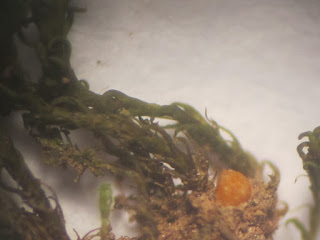Anyway, one patch of Weissia had a little orange fungus growing at its base. I figured that a fungus growing on Weissia multicapsularis could be pretty rare, so I carefully collected the fungus and 3 stems of the moss for identification. It looked rather ill-defined compared with most Octospora that I have seen, perhaps because of the membranaceous margin (something mentioned on the excellent Bryoparasitic Pezizales site http://www.octospora.de/Ltuberculatella.htm). Under the microscope it had remarkably lobed asci containing 8 strongly warted spores. A check on the Pezizales website suggested the only fungus recorded so far from Weissia species is Lamprospora tuberculatella, which has spores that are identical to my specimen. From what I can see on-line, there are no previous British records, so a very rare moss may support an even rarer (in British terms) fungus.
Monday, 15 February 2016
Rare fungus on Weissia multicapsularis
Anyway, one patch of Weissia had a little orange fungus growing at its base. I figured that a fungus growing on Weissia multicapsularis could be pretty rare, so I carefully collected the fungus and 3 stems of the moss for identification. It looked rather ill-defined compared with most Octospora that I have seen, perhaps because of the membranaceous margin (something mentioned on the excellent Bryoparasitic Pezizales site http://www.octospora.de/Ltuberculatella.htm). Under the microscope it had remarkably lobed asci containing 8 strongly warted spores. A check on the Pezizales website suggested the only fungus recorded so far from Weissia species is Lamprospora tuberculatella, which has spores that are identical to my specimen. From what I can see on-line, there are no previous British records, so a very rare moss may support an even rarer (in British terms) fungus.
Subscribe to:
Post Comments (Atom)





Excellent record Sam.
ReplyDeleteThe location really does look quite unremarkable. I'll be taking a closer look at such banks whenever I encounter them in the future, though I'll do well to match your diligence.
ReplyDeleteIndeed. We must miss species which grow in these kinds of habitats during our square bashing, as it's not exactly the kind of place you would think of targeting for bryos.
ReplyDeleteI've been checking large Funaria patches on bonfire sites for parasitic fungi, but without luck.